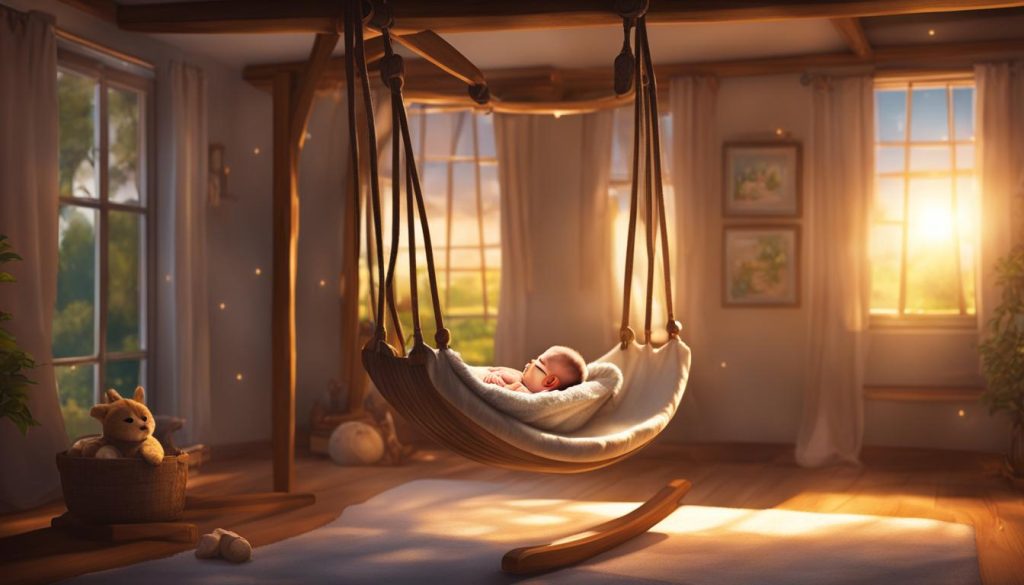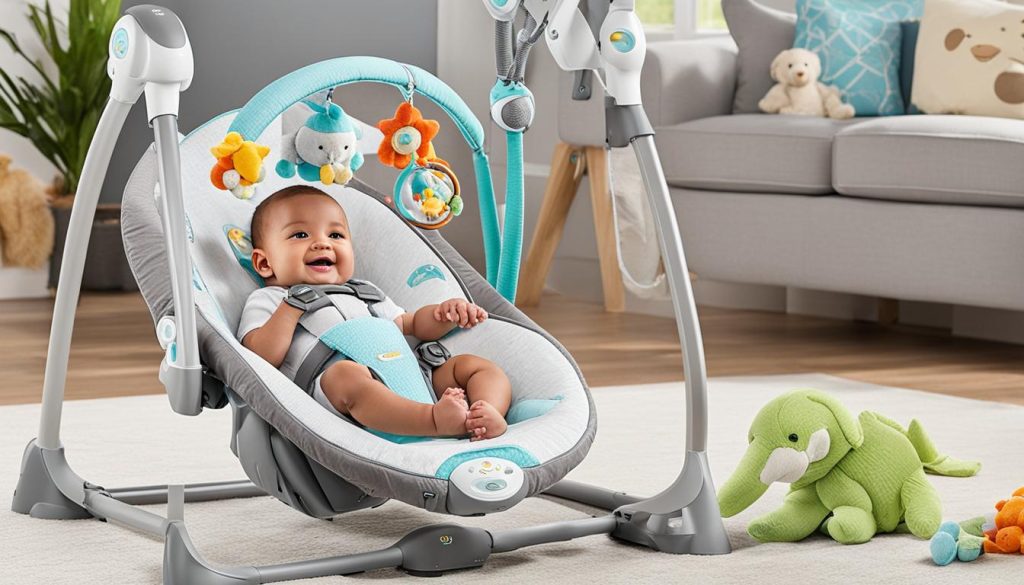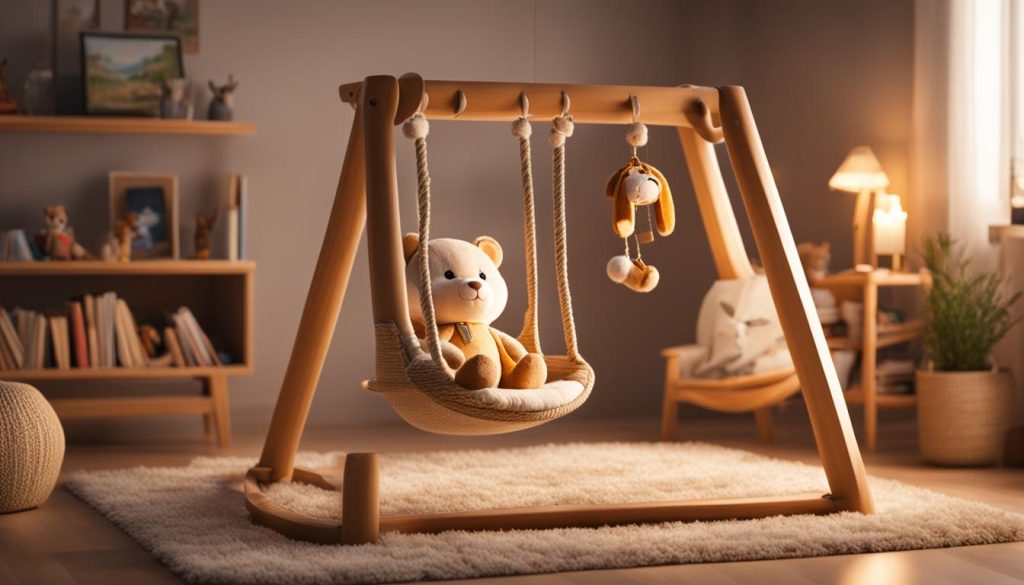I write this article to provide important information about newborns sleeping in swings. While many parents may think using a swing for their baby’s sleep is convenient, it’s essential to understand the potential risks associated with this practice.
Experts strongly advise against allowing newborns to sleep in swings. The use of baby swings for sleep has been linked to various concerns, including an increased risk of injury, flat spots on the head, blocked airways, suffocation, and even death.
It’s important to remember that baby swings are not designed for sleep purposes and can put infants in harm’s way. Infants who sleep in swings may experience difficulties breathing, head or neck injuries, and entanglement in the swing’s equipment. The upright position of a swing also poses challenges for young infants in terms of breathing.
Sleeping in tilted surfaces like swings may also lead to babies rolling onto their stomachs, which is a known risk factor for Sudden Infant Death Syndrome (SIDS). Additionally, prolonged use of swings for sleep can contribute to or worsen flat spots on the head and lead to torticollis, a condition where the neck twists and causes the head to tilt unnaturally.
To ensure your baby’s safety, it’s crucial to limit their time spent in swings, secure the straps properly, avoid using soft bedding or cushions, and always adhere to the manufacturer’s recommendations and safety standards.
The Importance of Safe Sleep for Newborns
Safe sleep is crucial for newborns to reduce the risk of SIDS and other sleep-related accidents. While it may be tempting to let your baby sleep in a swing for convenience or to soothe them, it’s important to understand why this is not recommended. Swings are not designed for sleep and can pose serious risks to your baby’s safety and well-being.
Newborns should always sleep on a firm, flat surface, such as a crib or bassinet, with no loose bedding or objects nearby. This helps reduce the risk of suffocation and keeps the sleeping environment safe. Placing babies on their backs to sleep is also essential in preventing SIDS, as studies have shown that this position significantly reduces the risk. It’s important for parents and caregivers to prioritize safe sleep practices and create a safe sleep environment for their newborns.
While a swing may seem like a convenient option for soothing a fussy baby or providing them with a cozy sleeping spot, it’s important to remember that swings are not designed for sleep and can increase the risk of injury and suffocation. Always follow the recommendations of pediatric experts and avoid using a swing as a substitute for a safe sleep surface. By prioritizing safe sleep practices, you’re ensuring the health and well-being of your newborn.
| Safe Sleep Tips for Newborns |
|---|
| Sleep on a firm, flat surface |
| Place baby on their back to sleep |
| Avoid loose bedding or objects in the sleep area |
| Follow pediatric experts’ safe sleep recommendations |
| Ensure a comfortable room temperature for sleep |
| Monitor your baby during sleep |
Remember, your baby’s safety should always come first. While a swing may seem like a convenient option, it’s essential to provide them with a safe sleep surface and follow recommended safe sleep practices. By creating a safe sleep environment, you’re giving your newborn the best start in life.
How to Safely Use a Baby Swing
While it is not recommended for newborns to sleep in a swing, baby swings can still be used to soothe and entertain infants when used safely and correctly. Here are some tips for safely using a baby swing:
1. Follow the Manufacturer’s Instructions
Before using a baby swing, thoroughly read and understand the manufacturer’s instructions. Each swing may have specific guidelines and safety recommendations that should be followed to ensure safe usage. Pay attention to weight limits, age recommendations, and any special instructions for securing your baby in the swing.
2. Always Supervise Your Baby
Never leave your baby unattended in a swing, even if they are sleeping or secured with safety straps. It’s important to keep a close eye on your baby to ensure their safety. If your baby falls asleep in the swing, consider moving them to a safe sleep surface, such as a bassinet or crib.
3. Use the Swing for Short Periods of Time
Limit the amount of time your baby spends in the swing. Prolonged periods in a swing can increase the risk of flat spots on the head, as well as potential breathing difficulties. Aim to use the swing for short intervals, allowing your baby to have plenty of supervised tummy time and time on a flat and firm surface.
4. Ensure a Safe Environment
Make sure the area around the swing is free from hazards. Keep cords, blankets, and toys away from the swing to prevent any accidental entanglements. Additionally, ensure that the swing is placed on a stable surface and cannot tip over.
By following these tips, you can safely use a baby swing to provide comfort and entertainment for your little one while minimizing the risks associated with prolonged sleep or unsupervised use.
| Safe Usage | Risk Factors | |
|---|---|---|
| 1. Proper Supervision | Always supervise your baby while they are in the swing to prevent accidents and ensure their safety. | Leaving your baby unattended in the swing can lead to potential hazards and increase the risk of injury or suffocation. |
| 2. Limit Time in the Swing | Use the swing for short periods of time to prevent issues such as flat spots on the head and breathing difficulties. | Prolonged use of the swing can lead to increased risks of certain health concerns for your baby. |
| 3. Follow Manufacturer’s Guidelines | Read and understand the manufacturer’s instructions for proper usage of the swing. | Ignoring the manufacturer’s recommendations can result in unsafe usage and potential accidents. |
| 4. Maintain a Safe Environment | Ensure the area around the swing is free from hazards and the swing is placed on a stable surface. | A cluttered environment or unstable placement of the swing can lead to accidents and injuries for your baby. |
Transitioning to Safe Sleep in a Crib or Bassinet
When it comes to ensuring safe sleep for newborns, transitioning from a swing to a crib or bassinet is an important step. While baby swings can be soothing and entertaining, they are not designed for sleep and pose risks to infants. To create a safe sleep environment and promote healthy sleep habits, here are some tips for transitioning your newborn to a crib or bassinet:
1. Establish a Consistent Sleep Routine
A consistent sleep routine plays a crucial role in helping newborns transition to a crib or bassinet. Set a regular bedtime and follow a soothing bedtime routine that includes activities like a warm bath, gentle massage, or lullabies. This routine helps signal to your baby that it’s time to sleep and can make the transition smoother.
2. Create a Safe Sleep Environment
Ensure that your newborn’s crib or bassinet is a safe sleep space. The American Academy of Pediatrics recommends a firm and flat mattress without any loose bedding, pillows, or stuffed animals. Use a fitted sheet that securely fits the mattress. Keep the sleep area free from any potential hazards, such as cords or curtains within reach.
3. Gradual Transition
Transitioning from the swing to a crib or bassinet can be done gradually to help your baby adjust. Start by letting your baby nap in the crib or bassinet during the day. Once they become comfortable, you can transition them to sleeping in the crib or bassinet for nighttime sleep as well. Providing a familiar sleep environment, such as using a swaddle or white noise machine, can also help ease the transition.
Remember, each baby is unique, and the transition process may take time. Be patient and responsive to your baby’s cues, and seek guidance from your pediatrician if you have any concerns or questions.
| Safe Sleep Transition Tips |
|---|
| Establish a consistent sleep routine |
| Create a safe sleep environment |
| Gradually transition from swing to crib or bassinet |
Expert Advice for Safe Sleep Practices
When it comes to ensuring the safety of your newborn during sleep, there are some important recommendations to keep in mind. First and foremost, remember that baby swings are not designed for sleep and should not be used as a substitute for a safe sleep surface like a crib or bassinet. However, if you do choose to use a swing for soothing or entertainment purposes, here are some tips to follow:
1. Supervision is key: Always supervise your baby when they are in a swing. Never leave them unattended, as this can increase the risk of accidents or suffocation.
2. Follow manufacturer’s instructions: It is crucial to carefully read and follow the manufacturer’s recommendations and safety standards for the specific swing you are using. This includes properly buckling the straps and using the swing according to the weight and age limits specified.
3. Limit swing time: While swings can be a convenient tool for calming fussy babies, it is important to limit the amount of time your newborn spends in the swing. Extended periods of time in a swing can increase the risk of positional asphyxiation and other potential hazards.
Remember, safe sleep practices are essential for your newborn’s well-being. Prioritize creating a safe sleep environment using a firm, flat surface such as a crib or bassinet, and always follow the guidelines provided by experts to minimize potential risks.





